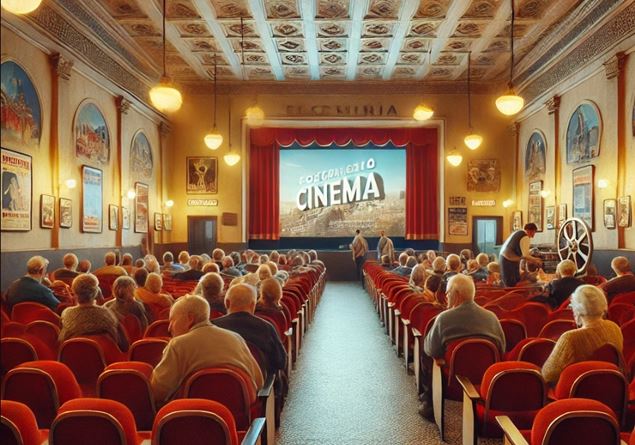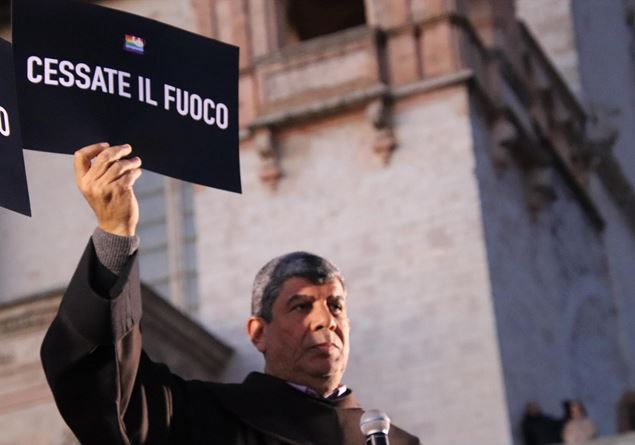
Paolo Castelli.
In Busto Arsizio, a Lombard town with a strong industrial identity, a silent revolution is taking place. It is not the usual revolution involving technology or social media, but one of those that have deep roots in tradition and that leverage the sense of community. We are talking about the comeback of parish cinemas, spaces that seemed destined to be swept away by the advent of large multiplexes and streaming platforms such as Netflix, but which today are experiencing a second youth. And if there is one person who embodies this movement more than anyone else, it is Paolo Castelli, one of the key figures in the rebirth of parish cinemas in the city of Busto and the Ambrosian diocese.
Paolo Castelli, today professor of history of contemporary art and languages of visual communication at the Polytechnic of Milan, leading expert in Italy on video-essays, graduated from Dams in Bologna (with a thesis on Long goodbye by Chandler transposed by Robert Altman), crazy about Truffaut, grew up immersed in the world of cinema. His father Giancarlo was a well-known scholar and film critic and passed on his love for the seventh art to his son since he was a child. «My father was good and competent», Paolo remembers fondly, «he was one of the first in Italy to write monographs on directors of the caliber of Altman and Arthur Penn. With him I saw masterpieces like The Leopard And Brother Sun, Sister Moon. Those experiences left a profound mark on me.”
The crisis of parish cinemas
In the 1990s, with the advent of large multiplexes and cable television, parish cinemas seemed destined to close their doors. These small cultural bastions, which for decades had been the point of reference for entire generations, were in economic and operational difficulty. The theaters emptied and the public’s interest shifted towards larger and more commercial models of entertainment. «I remember the years when the parish cinemas were empty and silence reigned where once there was life», says Paolo Castelli with a touch of bitterness. “It seemed as if these spaces were destined for oblivion.”
However, Castelli did not give up. Together with a group of enthusiasts and with the support of ACEC (Associazione Cattolica Esercizio Cinema), he contributed to bringing the parish cinemas of Busto Arsizio back to life, making it a city with the highest number of arthouse cinemas in relation to the population of all Italy. Not only to save them from closure, but to transform them into places where culture could be shared and discussed. «We didn’t want these cinemas to become just abandoned buildings», explains Paolo. One of these, the Oscar, is a crumbling giant that has stood tall in the city center for decades. Yet another, the Pozzi, has become an elegant residence. «But we saved the smaller cinemas. They were spaces that had meant a lot to the community, to families, to young people and to the elderly. We had to do something to keep them alive.”
The rebirth of parish cinemas: a new beginning
The rebirth process was long and not without difficulties. Thanks to the perseverance of Paolo Castelli and other volunteers like him, many parish halls have been renovated and equipped with new technologies. The old projectors have been replaced with cutting-edge digital systems, and the rooms have been equipped with new audio systems, making them competitive also from a technical point of view. «The transition to digital was fundamental», explains Castelli. «Without that leap in quality, we would not have been able to compete with the multiplexes. Now we can screen films in high quality and offer a remarkable cinematic experience, while maintaining the intimate atmosphere that characterizes us.” For example, Benedetta Russo, another very important volunteer protagonist of this rebirth process, says: «Unfortunately the old rooms, with all their sacrifices, their passion, anxieties, races, technological updates, adjustments to the Covid protocols, practically they disappeared. But our Fratello Sole film club was born independently with Father Flaviano and we faced everything with great sacrifices and economic struggles
with so much passion, without ever letting ourselves be discouraged.” Today, the parish cinemas of Busto Arsizio are not just screening rooms, but real cultural centers. They host conferences, meetings, film festivals and theater performances, becoming places of aggregation for the community. «People don’t come here just to see a film», explains Paolo. «They are called functional community theaters and they are doing great in order to transform Busto into the capital of arthouse cinema. A similar phenomenon of rebirth only exists in Paris.” Pensioners, families, young students «come to reflect, discuss, discuss. The parish cinema is a meeting place, where you feel part of something bigger.”
The parish cinemas of Busto Arsizio: a cultural bastion
The network of parish cinemas in Busto Arsizio is made up of some historic theaters which, thanks to the commitment of Paolo Castelli and his team, have rediscovered their centrality in city life. Every cinema has its own identity, its own target audience and a story to tell:
- Cinema Manzoni: Located in the heart of the city, owned by the San Filippo oratory, the Cinema Manzoni is one of the most representative cinemas in Busto Arsizio. «The Manzoni has a very varied programme», explains Castelli, «from first-run films to the great Italian classics. Every Wednesday, for example, we offer a review dedicated to the masterpieces of our cinema. It’s incredible to see how many people take part in these evenings, especially elderly people who haven’t been to the cinema for years.”
- Cinema Lux (Sacconago): Known for its attention to families, Cinema Lux has become the ideal place for screening films for children and teenagers. «Every weekend we screen animated films for children and families», says Castelli. «It is a special opportunity to bring young people closer to cinema, making them understand that this space can be something more than just a screening room».
- St. John Bosco: Located in the parish of the same name, San Giovanni Bosco, it is part of the oratory of Sant’Edoardo. Cinema of the Arts: Another cinema, in Gallarate, which has managed to carve out a space for itself in the cultural panorama of the city. Festivals of auteur cinema and meetings with directors are often held here. «It is a smaller theater than the others», explains Castelli, «but it has a very loyal audience, especially among young cinephiles. The Cinema delle Arti is the right place for those looking for stories outside the commercial circuit.”
- Aurora Cinema (Borsano): Even though it is closed today, the Cinema Aurora is still a symbol for many inhabitants of the hamlet of Borsano. «There are many people who still hope for its reopening», confesses Castelli. «It is a room that has made the history of the hamlet, and who knows, one day we might bring it back to life».
- Social. Concerts and theatrical performances also take place here. It is dedicated to the theater scholar Delia Cajelli.
- Brother Sun, managed by the Franciscans is the one in which Castelli has a direct involvement as curator of the film club. And it shows.
- Rats. Historic cinema of Legnano, it is part of the arthouse circuit.
The parish cinema as a place of cultural resistance
In the midst of the digital age, in which Netflix and multiplexes seem to dominate the entertainment landscape, the rebirth of parish cinemas in Busto Arsizio represents, as Castelli calls it, “an act of resistance.” “Our audience is different,” he says. «You don’t come here just to see a film, but to live a shared experience. People want to go back to feeling the emotions of a room, to hear the reaction of others, to talk about what they saw. This is the true power of cinema: bringing people together.”
The idea of cinema proposed by Castelli goes beyond simple entertainment. In the parish cinemas of Busto Arsizio, cinema is a pretext to create a bond, to build a community. «What we are doing», says Castelli, «is creating a space for reflection, exchange and collective growth. And this, in an increasingly individualistic world, is something extraordinary.”
Film school: training the filmmakers of the future
One of the most interesting developments linked to the rebirth of the parish cinemas of Busto Arsizio is the birth of a film school, strongly desired on the initiative of Castelli, who is also among the founders of the Baff, Busto Arsizio Film Festival, an event which from year to year year it gains acclaim and participation from all over Italy, with a showcase of top-notch directors and actors. «We understood that to guarantee a future for these cinemas, we had to involve the new generations», explains Castelli. The school, financed by the Lombardy Region, offers post-diploma courses in directing, screenwriting, editing and acting. «We have around 60 students enrolled», says Castelli, «and many of them have already started working in the world of cinema. It is an immense satisfaction to see these kids grow, learn and become professionals.”
The school represents a bridge between past and future, between the legacy of parish cinema and new technologies. «We are training the filmmakers of the future», explains Castelli. «Cinema is not just an art, it is a way to tell stories, to make us reflect, to excite us. And as long as there are people willing to tell stories, cinema will never die.”
Between past and future, a new cinema
The rebirth of parish cinemas in Busto Arsizio is a story of passion, determination and community. Thanks to the commitment of Paolo Castelli and his team of volunteers, these rooms have come back to life, once again becoming an integral part of city life. And just like in the movie New Cinema Paradisowhich celebrates the bond between a small town and its cinema, cinema has once again become a point of reference for everyone in Busto Arsizio. «But here, unlike the film», concludes Castelli with a smile, «the kisses are no longer cut».
the photos of this service are by Paolo Stelluti.







